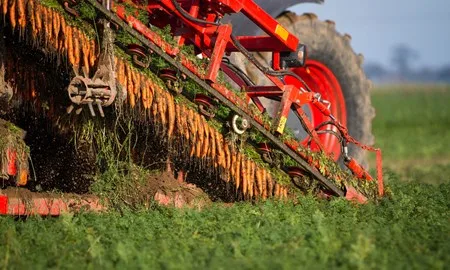
Velum Prime (fluopyram) has demonstrated strong suppression of spraing symptoms caused by tobacco rattle virus (TRV) on land heavily infested with free-living nematodes.
Author
| 1st February 2023Tackling FLN in potatoes and carrots with Velum Prime
Velum Prime (fluopyram) has demonstrated strong suppression of spraing symptoms caused by tobacco rattle virus (TRV) on land heavily infested with free-living nematodes.
In trials spanning six years, Velum Prime reduced spraing symptoms by about 40% compared with the untreated. This was on sites which, on average, contained 2260 stubby-root nematodes (Trichodorus spp.) per litre of soil, and was broadly in line with that of the comparative treatment containing fosthiazate.
Velum Prime reduced TRV symptoms by about 40% over the untreated
Source: Bayer-commissioned trials, 2016-21. Average of 2260 Trichodorus spp. per litre of soil.
The nature of TRV transmission means control can be difficult, so Velum Prime must be used to as part of a wider suite of integrated measures beginning with suitable site selection.
Tobacco rattle virus symptoms vectored by stubby-root nematodes (Trichodorus spp.)
Carrots
Free-living nematodes can inflict significant damage on crops by feeding on plant roots. In carrot and parsnip crops this can lead to stunted growth and fanging (where multiple tap roots form) with water and nutrient uptake often compromised as a result. The affect on performance often reflects the nematode pressure, but even in mild infestations, the financial impact through a loss in marketable yield can be considerable.
The absence of nematode resistant varieties means growers are reliant on nematicides to protect yields in the growing crop and cultural controls such as long rotations and suitable cover crops for management outside the crop.
The effectiveness of cultural measures, however, has been highly variable and often significantly worse than seen with cyst nematodes. This is in part due to the range of species involved. Research in Michigan, USA, for example, found that it took nearly a year for populations of root-knot nematode (Meloidogyne spp.) to change following a crop of oil radish while the root-lesion nematode (Pratylenchus penetrans) has such a wide host range, which includes oats, radish and oilseed rape, that efforts to manage it are often compromised by other activities.
Faced with such a reality, trials sought to establish the yield protection delivered by Velum Prime (fluopyram), the liquid nematicide that can be applied by boom sprayer and incorporated to a depth of 10-20 centimetres up to 72-hours before drilling.
Chart 1 shows the results of a 2021 trial at Hockwold, Norfolk where Velum Prime increased marketable yields by nearly 40% compared with the untreated and 4.5% over Nemguard DE (garlic extract).
Chart 1: Velum Prime delivered a 37% increase in marketable yield over the untreated and beyond that achieved by Nemguard DE
Reference: VCS, 2021 FLN carrot trial, Hockwold. Cv. Nairobi
Perhaps, more telling is the reduction in symptoms caused by free-living nematodes delivered by Velum Prime compared with Nemguard DE.
Chart 2 shows how Velum Prime reduced the incidence of fanging by nearly twice that achieved by Nemguard DE.
Chart 2: Velum Prime reduced the quantity of roots affected by fanging by 72% compared with untreated – almost twice that achieved by Nemguard DE
Source: VCS, 2021 FLN Carrot trial, Hockwold. Cv. Nairobi
The results, which build on the performance seen in previous trials, provide compelling evidence of the yield protection afforded by Velum Prime under commercial conditions.
Pre-sowing soil testing found the site contained a range of species, including Stubby-root nematodes (Trichodorous spp.), Stunt nematodes (Tylenchorynchus spp.), spiral nematodes, (Helicotylenchus spp.), root-lesion nematodes (Pratylenchus penetrans) and needle nematodes (Longidorus spp.).